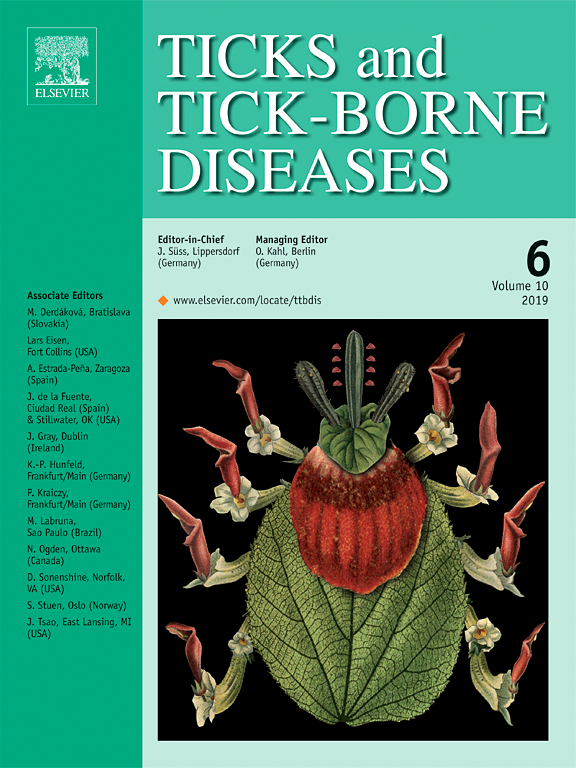View Item
- xmlui.general.dspace_homeCentros Regionales y EEAsCentro Regional Santa FeEEA RafaelaArtículos científicosxmlui.ArtifactBrowser.ItemViewer.trail
- DSpace Home
- Centros Regionales y EEAs
- Centro Regional Santa Fe
- EEA Rafaela
- Artículos científicos
- View Item
Borrelia spp. in ticks and birds from a protected urban area in Buenos Aires city, Argentina
Abstract
This study was aimed to know epidemiological aspects of Borrelia spp. in a protected urban area of Buenos Aires city, Argentina, where thousands of people visit this area for recreational purposes. Ticks were collected from vegetation, birds and dogs. Three hundred and forty birds belonging to 43 species, 41 genera, 18 families and six orders were captured (90.3% corresponded to the order Passeriformes). One hundred and twenty ticks were collected from 47
[ver mas...]
This study was aimed to know epidemiological aspects of Borrelia spp. in a protected urban area of Buenos Aires city, Argentina, where thousands of people visit this area for recreational purposes. Ticks were collected from vegetation, birds and dogs. Three hundred and forty birds belonging to 43 species, 41 genera, 18 families and six orders were captured (90.3% corresponded to the order Passeriformes). One hundred and twenty ticks were collected from 47 birds (13.8%) belonging to 10 species (23.2%), all of them from to the order Passeriformes (Emberizidae, Furnariidae, Parulidae, Thraupidae, Troglodytidae, Turdidae). Ticks were identified as Ixodes auritulus (56 larvae, 44 nymphs and 8 females) and Amblyomma aureolatum (1 larva and 11 nymphs).
One thousand and ninety-one ticks collected from vegetation, 100 ticks collected from birds, and 89 ticks from dogs were tested for Borrelia infection by PCR trials targeting the flagellin (fla) and 16S rRNA genes. In addition, 101 blood and 168 tissue samples from birds were analyzed. Nine nymphs of A. aureolatum (2.1%) and four nymphs of I. auritulus (0.7%) collected from vegetation were positive. Five nymphs of A. aureolatum (45.4%), and five pools of larvae (minimum infection rate 13.5%), 18 nymphs (40.9%) and one female (14.3%) of I. auritulus collected on birds were also positive. The remaining samples were negative. The phylogenetic tree generated with fla sequences shows that seven of the eight different haplotypes of Borrelia detected in I. auritulus conform an independent lineage within the Borrelia burgdorferi sensu lato complex together with sequences of Borrelia sp. detected in I. auritulus from Canada and Uruguay. The fla sequences of Borrelia obtained from A. aureolatum and one sequence of a single specimen of I. auritulus conform a phylogenetic group with Borrelia turcica, Borrelia sp. isolated from a tortoise in Zambia, Borrelia spp. detected in Amblyomma maculatum from USA and Amblyomma longirostre from Brazil. The epidemiological risk that implies the infection with Borrelia genospecies associated with I. auritulus seems to be low because this tick is not aggressive to humans, but it helps to maintain borrelial spirochetes in the enzootic transmission cycles. The pathogenicity to humans of the Borrelia found in A. aureolatum is unknown; however, adults of this tick species are known to bite humans. This is the first report of the presence of Borrelia in A. aureolatum. Further investigations are necessary to know the risk of transmission of borreliosis by hard ticks in the study area.
[Cerrar]

Author
Cicuttin, Gabriel L.;
De Salvo, María Nazarena;
Venzal, José Manuel;
Nava, Santiago;
Date
2019-10
Editorial
Elsevier
ISSN
1877-959X
Formato
pdf
Tipo de documento
artículo
Palabras Claves
Derechos de acceso
Restringido
 Excepto donde se diga explicitamente, este item se publica bajo la siguiente descripción: Creative Commons Attribution-NonCommercial-ShareAlike 2.5 Unported (CC BY-NC-SA 2.5)
Excepto donde se diga explicitamente, este item se publica bajo la siguiente descripción: Creative Commons Attribution-NonCommercial-ShareAlike 2.5 Unported (CC BY-NC-SA 2.5)

